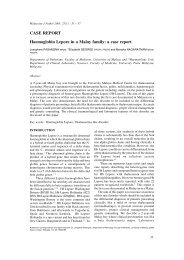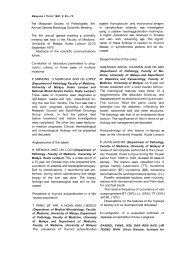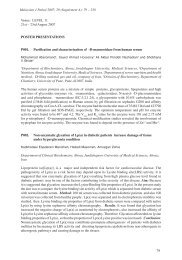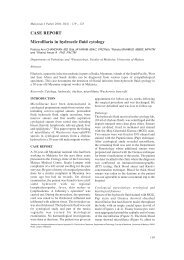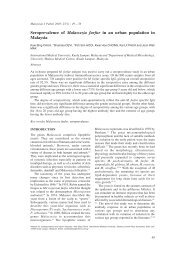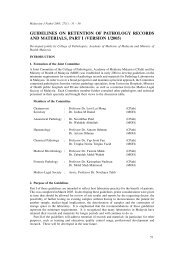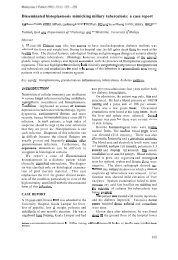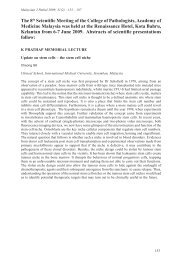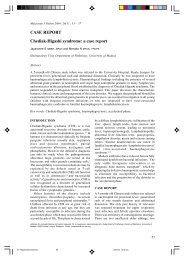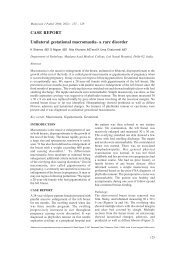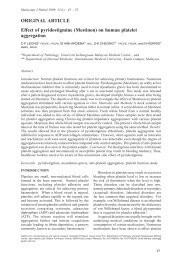Information for authors - The Malaysian Journal of Pathology
Information for authors - The Malaysian Journal of Pathology
Information for authors - The Malaysian Journal of Pathology
Create successful ePaper yourself
Turn your PDF publications into a flip-book with our unique Google optimized e-Paper software.
<strong>Malaysian</strong> J Pathol June 2008EthicsWhen reporting experiments on human subjects, indicate whether the procedures followed werein accordance with the ethical standards <strong>of</strong> the responsible committee on human experimentation(institutional or regional) and with the Helsinki Declaration <strong>of</strong> 1975, as revised in 2000. Do not usepatients’ names, initials, or hospital numbers, especially in illustrative material. When reportingexperiments on animals, indicate whether the institution’s or a national research council’s guide <strong>for</strong>,or any national law on, the care and use <strong>of</strong> laboratory animals was followed.ResultsPresent your results in logical sequence in the text, tables, and figures. Do not repeat in the text all thedata in the tables or figures; emphasize or summarise only important observations.DiscussionEmphasise the new and important aspects <strong>of</strong> the study and the conclusions that follow from them. Donot repeat in detail data or other material given in the Introduction or the Results sections. Include inthe Discussion section the implications <strong>of</strong> the findings and their limitations, including implications <strong>for</strong>future research. Relate the observations to other relevant studies.AcknowledgmentsSpecify (a) contributions that need acknowledging but do not justify <strong>authors</strong>hip, specifying the nature<strong>of</strong> their contribution (such as general support by a departmental Head, critical review <strong>of</strong> the paper, datacollection); (b) acknowledgments <strong>of</strong> technical help; (c) acknowledgments <strong>of</strong> financial and materialsupport, specifying the nature <strong>of</strong> the support; (d) relationships that may pose a conflict <strong>of</strong> interest; and(e) disclaimers, if any.REFERENCESNumber references consecutively in the order in which they are first mentioned in the text. Identifyreferences in text, tables, and legends by Arabic numerals in superscript. References cited only in tablesor in legends to figures should be numbered in accordance with the sequence established by the firstidentification in the text <strong>of</strong> the particular table or figure.<strong>The</strong> titles <strong>of</strong> journals should be abbreviated according to the style used in the Index Medicus.References should be verified by the author(s) against the original documents. Authors are responsible<strong>for</strong> the accuracy <strong>of</strong> their references.Examples <strong>of</strong> common <strong>for</strong>ms <strong>of</strong> references are given below. Further examples are available fromwww.nlm.nih.gov/citingmedicine(1) Standard journal article(List all <strong>authors</strong> when six or less; when seven or more, list only the first three <strong>authors</strong>followed by et al).Ellis IO, Coleman D, Wells C, et al. Impact <strong>of</strong> a national external quality assessmentscheme <strong>for</strong> breast pathology in the UK. J Clin Pathol. 2006; 59: 138-45.(2) Book with personal author(s)Modlin IM, Sachs G. Acid related diseases: biology and treatment. 2 nd ed. Philadelphia:Lippincott Williams & Wilkins; c2004. 522 p.(3) Book with Editor(s), compiler(s) as authorIzzo JL Jr, Black HR, editors. Hypertension primer: the essentials <strong>of</strong> high blood pressure.3rd ed. Philadelphia: Lippincott Williams & Wilkins; c2003. 532 p.ii68




